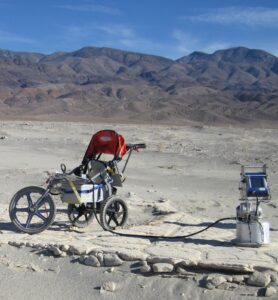Dust from wind traveling across open land areas is a common phenomenon on all continents of the world. Whether a tilled field or a geographic feature like a dry lakebed, these areas can emit dust that impacts public respiratory health. Knowing the potential for adverse health effects is difficult to quantify. Varying surface conditions, weather, and rates of emission are inherent to this challenge.
In tackling this problem, air quality experts use methods rooted in a laboratory setting and in the field (in situ). Lab work striving to re-create in situ conditions such as wind tunnels, presents the immediate problem that the collected samples have been transported, leaving scientists only to hope that reconstitution of the original surface is similar. The lab permits, however, a high level of control in developing theoretical concepts. Field work has a different set of issues. While actual existing soil and surface conditions can be analyzed in place using, for example, a 40-foot portable wind tunnel, the endeavor is time- and resource-intensive. Imagine a hybrid of the two, a portable field laboratory.

PI-SWERL can access nearly any site to assess potential wind erosion. Portability means replicability in testing.
Rubber Baby Buggy Bumpers
The Desert Research Institute (DRI) has developed just that: the portable in-situ wind erosion lab (PI-SWERL). At first glance you’d think it’s a beefy stroller carrying an upside-down pot. Seated in an all-terrain baby jogger, the open-bottomed, cylindrical chamber — the size of a dinner plate — houses a direct-current motor that spins a metal ring about 10 centimeters above and parallel to the soil surface. The spinning ring creates a known wind shear, lofting soil, sand, and dust particles. Dust particulate sensors in the housing measure the number and size of particles during the test cycle, which is typically less than 10 minutes. Although dust is generated in a circular, “swerl”-ing fashion versus linear (as found in nature), PI-SWERL results compare favorably to data from larger wind tunnels (Sweeney et al, 2008). This method allows scientists to measure the potential for wind erosion and dust emission from soil surfaces.
Major PI-SWERL benefits include:
- Efficiency, at just 10 minutes per test, up to 30 readings per day for potential dust impact are possible.
- Portability, the all-terrain jogger can navigate most landforms.
- Accessibility, the equipment is available for rental, keeping costs low.
- Scalability, data can be integrated with other methods to form a broader picture.
- Customizable, range spans a complete emission inventory to something more contained, like documenting dust control at a construction site.
Air Sciences has been using PI-SWERL at Owens Lake since 2009 to characterize a variety of landforms surrounding the dry lakebed, such as dunes and alluvial fans, which can be highly emissive at times. Combining data from remote sensing, dispersion modeling, and PI-SWERL, we’re able to assess potential air pollution effects on communities. One more example of Air Sciences’ commitment to finding creative, versatile solutions to client challenges.
Further reading:
Etyemezian, Vic, George Nikolich, Sean Ahonen, Marc Pitchford, Mark Sweeney, Rick Purcell, John Gillies, Hampden Kuhns. “The Portable In Situ Wind Erosion Laboratory (PI-SWERL): A new method to measure PM10 windblown dust properties and potential for emissions,” Atmospheric Environment 41, 18 (2007): 3789–3796. https://doi.org/10.1016/j.atmosenv.2007.01.018.
Sweeney, Mark, Vic Etyemezian, Torin Macpherson, William Nickling, John Gillies, George Nikolich, Eric McDonald. “Comparison of PI-SWERL with dust emission measurements from a straight-line field wind tunnel,” Journal of Geophysical Research: Earth Surface 13, F1 (2008). https://doi.org/10.1029/2007JF000830.

